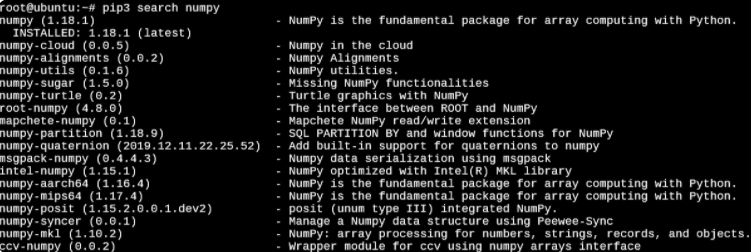
List command is similar to the pip freeze command except command lists installed packages along with their versions in a two column tabular format.
PIP3 LIST INSTALLED PACKAGES INSTALL

Requirements file generated this way contains all installed packages along with their dependencies. In order to see a list of all packages installed using pip you can use pip list command in the terminal.One can generate a requirements file using freeze command - $ pip freeze > requirements.txt Although very handy, requirements.txt file using freeze option is not considered a best practice for the below reasons: To find the path to installed packages on your Linux machine, type: pip3 show somepackage grep Location.
PIP3 LIST INSTALLED PACKAGES HOW TO
Now pip list -user correctly lists only user installed python packages from the python3.Enter fullscreen mode Exit fullscreen mode How to generate requirements.txt using freeze command After reinstalling Python packages with pip install -user, a python3.7 user site directory was created in ~/.local. To list all packages installed: pip list. A workaround is to fire up the python shell and do this: > import eventlet > eventlet.path /usr/lib/python2.7/dist-packages/eventlet where 'eventlet' is the package I installed with pip. Pip is a package management system used to install and manage Python packages. Because I upgraded pip to pip 18.1 which uses python 3.7 instead of python3.6 pip list -user outputted an empty list which is expected because no python3.7 packages have been installed in the python 3.7 user site directory. Two years later, most pip instances have show, however, not all packages have the installed-files.txt program for the subcommand to read. There was no Python3.7 user site directory, only a Python3.6 user site directory existed.

Pip3 list -user should list user site packages I think this is the reason I am getting the error ModuleNotFoundError: No module named 'virtualenvwrapper' when a script tries importing virtualenvwrapper ~/.local/lib/python3.6/site-packages but pip3 list -user does not show any of the python modules installed in ~/.local/lib/python3.6/site-packages instead pip3 list -user outputs an empty list. pip3 list -user should list only packages installed in the user site directory i.e. I have several user installed Python modules in the user site directory ~/.local/lib/python3.6/site-packages one of which is virtualenvwrapper. pip3 list -o -format columns cut -d' ' -f1xargs -n1 pip install -U Explanation Let’s explain how that command works. pip version: pip 18.1 from /usr/lib/python3.7/site-packages/pip (python 3.7).


 0 kommentar(er)
0 kommentar(er)
